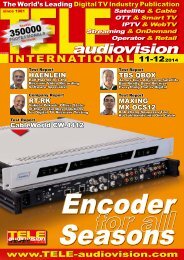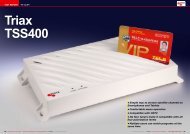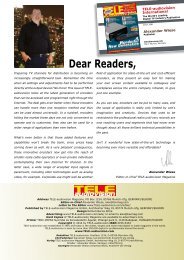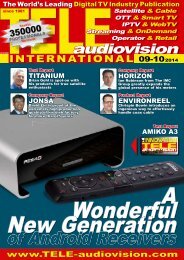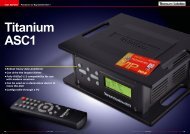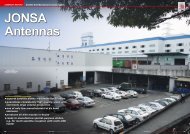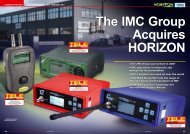eng TELE-audiovision 1305
The World’s Largest Digital TV Trade Magazine
The World’s Largest Digital TV Trade Magazine
You also want an ePaper? Increase the reach of your titles
YUMPU automatically turns print PDFs into web optimized ePapers that Google loves.
TEST REPORT<br />
CyberTenna<br />
I<br />
S64 for Eight Satellites<br />
Wind and Snow? No Problem!<br />
t was about a year ago when we first<br />
introduced this satellite antenna that<br />
was based on the lens principle. Since<br />
then the design has been perfected and<br />
it was decided that this antenna concept<br />
needed to be looked at more closely<br />
once again. The idea of receiving mul-<br />
tiple satellites with a fixed antenna is<br />
becoming more and more popular. And<br />
in many cases it’s for reasons of neces-<br />
sity. The prevailing reason is the private<br />
use on a balcony or a terrace. The noise<br />
from a motorized antenna could wake<br />
the neighbors and may even make them<br />
angry. Another reason would be Internet<br />
via satellite access. While one LNB could<br />
be used exclusively for Internet access,<br />
the remaining seven LNB’s could be used<br />
independently for satellite TV and radio<br />
reception. In apartment houses with<br />
multinational tenants an antenna like this<br />
would be able able to serve the needs of each<br />
group and it could be done much more<br />
inexpensively than using multiple single<br />
antennas.<br />
But what about using two multifeed dishes<br />
each with three LNB’s? Such a set up would<br />
allow you to receive six satellites. The problem<br />
here is that two LNB’s would be missing (if the<br />
need is there) but more importantly the LNB’s<br />
sitting in the offset position of the antenna<br />
would have to deal with less amplification from<br />
the antenna’s reflector. Outside of that, this<br />
kind of antenna would have difficulty dealing<br />
with 2° of separation between adjacent satel-<br />
lites and many multifeed antennas would even<br />
have trouble with the more standard 3° separa-<br />
tion (e.g. 19°, 16°, 16°, 13°, 10°, 7° and so on). In<br />
our tests we were able to achieve a 2° offset<br />
using Digistar SF-1 LNB´s.<br />
TeleWide, the manufacturer of this antenna,<br />
has its headquarters in Sweden. In this part of<br />
the world you always need to keep in mind that<br />
snow accumulation on an antenna is a constant<br />
problem. With prime focus antennas, winter<br />
snow has a tendency to collect on the reflec-<br />
tor making it essentially unusable. With offset<br />
dishes it is the lower half of the reflector that is<br />
affected by the white stuff. For these reasons<br />
and also for the reasons mentioned above, Tel-<br />
eWide developed the CyberTenna S64. It was<br />
designed for use in the 10.7 to 12.75 GHz range.<br />
The most prominent feature of this antenna is<br />
the lens assembly with a shape that looks much<br />
like a car tire. Up to eight LNB’s sit behind the<br />
lens at a distance of about 85cm (33.5 inches).<br />
Signal amplification actually takes place opti-<br />
cally. The LNB’s are aimed at the middle of the<br />
16cm (6.3 inch) wide hole in the lens assem-<br />
bly. The incoming satellite signals are bundled<br />
together and amplified by the antenna and<br />
then delivered to the LNB’s. The gain at 11.7<br />
GHz is about 36 dBi and this is similar to a high<br />
quality 65cm (25.5 inch) antenna. Normally an<br />
antenna this size has a beamwidth of approxi-<br />
mately 3° and this would lead to interference<br />
between individual satellites spaced 3° apart.<br />
The CyberTenna has no interference problems<br />
from neighboring satellites. Only with 24 dBi is<br />
a beamwidth of 3° first reached.<br />
Everyday Use<br />
Set up of this antenna is simple. The logical<br />
layout and the well-written user manual allow<br />
assembly in just a couple of minutes. Tools are<br />
not necessary since all the screws come with<br />
an easy grip that allows them to be easily tight-<br />
ened. The LNB’s are fastened using an easy<br />
yet very stable clamp fitting. With the help of<br />
included graphics, the individual LNB holders<br />
are mounted to a rail in the proper position<br />
so that the desired satellites can be received.<br />
This actually works quite well although a scale<br />
imprinted on the rail would make the job even<br />
easier. Since the signals from up to eight LNB’s<br />
need to arrive at the receiver in a single cable,<br />
it is also necessary to use a multiswitch to link<br />
everything together. The focal point of 85cm<br />
(33.5 inches) is automatically obtained during<br />
the antenna’s assembly but small fine-tuning<br />
adjustments would be necessary and are pos-<br />
sible. The entire antenna is attached to a mast<br />
via a mount on the side of the antenna’s ring.<br />
On the same side the feed arm running back<br />
to the LNB rail is mounted. We were not too<br />
happy with this solution a year ago since all the<br />
weight of the antenna (9 kg, 19.8 LBS) was on<br />
one side of the the mast. In the meantime though,<br />
the mount was greatly improved making the<br />
entire antenna assembly much more stable.<br />
The alignment of the antenna is very easy. The<br />
LNB for the southernmost satellite is mounted<br />
in the center of the rail. For Munich this was<br />
HOTBIRD at 13° east. Munich lies at 12.7°<br />
east. The difference of 0.3° is insignificant.<br />
The final step is the elevation adjustment.<br />
Once this is done, satellite reception can begin.<br />
If the other seven (or less) LNB’s are installed<br />
in the proper location, reception of all the other<br />
desired satellites is now possible. In our tests<br />
two LNB’s required minor adjustments. An<br />
included template with all the regional DTH sat-<br />
ellites greatly helps with the alignment.<br />
All new DTH satellites deliver very strong<br />
signals and as such present no problems for<br />
the CyberTenna S64. In our tests we were able<br />
to receive the following satellites: ASTRA 1 and<br />
2, EUTELSAT W1/2/3 and HOTBIRD. All desired<br />
satellites should be within an azimuth range of<br />
26°. With extremely strong signals this range<br />
could be expanded. The CyberTenna’s 90°<br />
elevation adjustment allows it to by installed<br />
anywhere on the globe: from northern Scandi-<br />
navia, to the Equator to South Africa.<br />
Conclusion<br />
At a price of about $535 (535 Euros), this<br />
antenna isn’t exactly cheap. The cost of the<br />
LNB’s must also be considered. But what<br />
you get for your money is solid Swedish<br />
quality. The CyberTenna S64 is mostly unaf-<br />
fected by wind and it really has no surface<br />
where snow can accumulate. Mounted on a<br />
balcony it would be very hard to recognize<br />
this as a satellite antenna. Its amplification<br />
is more than sufficient for most DTH satel-<br />
lites. Its mechanical construction is excel-<br />
lent and its rust proofing guarantees a long,<br />
healthy life.<br />
<strong>TELE</strong>satellite<br />
INFO-BOX<br />
Manufacturer:<br />
TeleWide AB, Skellefeteá/Sweden<br />
Fax:<br />
+46-91017348<br />
E-Mail:<br />
info@telewide.se<br />
Model:<br />
CyberTenna S64<br />
Function:<br />
Fixed digital lens antenna for 8 Satellites<br />
Azimuth Range:<br />
26° and more<br />
Material:<br />
Technical EPS<br />
Gain:<br />
36 dBi/11.7 GHz<br />
Frequency Range:<br />
10.7-12.75 GHz<br />
Cross Polarization at +/- 3°:<br />
>34 dB<br />
Cross Polarization at +/- 0°:<br />
>22 dB<br />
Diameter:<br />
80 cm<br />
Elevation:<br />
0-90°<br />
F/D Ratio:<br />
1<br />
Separation Angle:<br />
from 2°<br />
Weight:<br />
9 kg<br />
Global Approval:<br />
yes<br />
TEST REPORT<br />
CyberTenna<br />
84 <strong>TELE</strong>-satellite International — The World‘s Largest Satellite Magazine — www.<strong>TELE</strong>-satellite.com Satellite Home Pages — www.SatcoDX.com www.DrDish.com www.Sat-City.com www.Sat-News.com<br />
85<br />
HiTOP<br />
Si-dTV & Ti-dTV<br />
The First Portable Receiver for<br />
DVB-S and DVB-T<br />
TEST REPORT<br />
20 <strong>TELE</strong>-satellite International — The World‘s Largest Satellite Magazine — www.<strong>TELE</strong>-satellite.com Satellite Home Pages — www.SatcoDX.com www.DrDish.com www.Sat-City.com www.Sat-News.com<br />
21<br />
T<br />
he desire for mobile satellite recep- plugged into the side of the HiTOP. Both here there are alternatives. The Digiglobe<br />
tion is as old as the DTH era itself. receivers are also fitted with slots for two antenna featured in this issue would be an<br />
There have always been small port- PayTV CA modules.<br />
ideal solution. The excellent input sensitivable<br />
TV’s for analog terrestrial recepity<br />
of this portable receiver would also make<br />
tion whose characteristics included only<br />
what was absolutely necessary. The Ti-dTV<br />
it a perfect choice for use with those small<br />
camping satellite antennas. The installation<br />
move towards mobility was somewhat<br />
of a portable satellite receiver should be<br />
faster with computers. The bulky PC’s As with all other receivers, the first step is especially simple.<br />
found in the home soon found them- to set it up the way you like. The available<br />
selves next to small colleagues – the menu languages for the Ti-dTV are German, HiTOP didn’t miss the boat here either.<br />
Laptop – that today are a normal tool for Russian, Chinese and English. Additional Communicating with the receiver can be<br />
wireless Internet access.<br />
languages will become available in future accomplished in English, Spanish, French,<br />
software updates. Just like with a satellite German, Italian and Russian. After activat-<br />
The idea to make one Notebook for ter- receiver, an automatic channel scan would ing the desired satellites in C and Ku-band<br />
restrial digital TV/radio reception (DVB-T) need to be run. And if you are a beginner and and after matching the local oscillator<br />
and another for digital satellite reception don’t know exactly what DVB-T parameters frequency (LOF) with the LNB, the signal<br />
naturally did not come from Europe or North are in use where you are, the Ti-dTV makes str<strong>eng</strong>th and quality are displayed. These<br />
America. No, this idea came from Taiwan. things easy for you by asking you where you virtual “gauges” react very fast to antenna<br />
Both receivers - the HiTOP Si-dTV (DVB-S) live. This menu lists every country that is movements and make finding the desired<br />
and the Ti-dTV (DVB-S) – weigh a mere 2Kg either testing or regularly using DVB-T. A satellites extremely easy.<br />
(4.4 LBS) and are about the same size as an channel scan can be set to either “Fast”<br />
A4 sheet of paper (8.3 x 11.7 inches). From or “Detailed”. In “Fast” mode the receiver The channel scan can be refined to look for<br />
the outside both receivers look like one only scans preset, country-specific channels ALL or FTA channels and can complete a scan<br />
another. Both of them come with a multi- while in “Detailed” mode the entire band is of an 80-transponder satellite in just about<br />
tude of accessories: external power supply, scanned. If the data for a regional chan- five minutes. SCPC signals starting at 2 Ms/<br />
3.5 hour rechargeable battery, 12 volt car nel is known, it can be manually activated. sec were no problem for this box but it would<br />
power adapter, stereo headphones, carrying After a channel scan, the Edit menu helps to require using a larger antenna. Even in the<br />
case and all necessary video cables. Just like organize all of the new channels that were satellite model the basic version comes with<br />
with a notebook computer, the upper half of found. Popular programs can be moved to a only 400 channels. This is not nearly enough<br />
the 35mm thick receiver opens up to reveal Favorites list and can quickly be recalled with especially if this box is also to be used with<br />
a 7” LC video screen in 16:9 format. Under- the simple push of a button. An Electronic your antenna at home. If you decide to buy<br />
neath the video screen are two speakers for Program Guide (EPG) takes the place of the this receiver you should without a doubt opt<br />
stereo audio. The remote control is located typical printed TV programming guide. The for the version with 1500 channels. The Si-<br />
in the lower half of the assembly. With the Ti-dTV also comes equipped with a teletext dTV also has an Edit function, a Favorites list,<br />
remote placed in its holder, the receiver can decoder allowing these services to be dis- a teletext decoder and an Electronic Program<br />
be controlled directly on the unit. With it played even on a monitor. The basic version<br />
removed from its holder, additional control of the Ti-dTV can store up to 400 channels.<br />
Guide.<br />
buttons on the receiver are revealed. This This should be enough for terrestrial TV<br />
guarantees that even if the batteries run out reception but if more channels are needed, Conclusion<br />
in the remote control, the receiver can still be there’s also a receiver version with 1500<br />
used. Despite this receiver being so flat, it is channels or more.<br />
The Si-dTV version for digital satellite<br />
still very nicely equipped on the rear panel.<br />
reception is a wonderful toy! But also well<br />
The antenna signal is looped through in both The type of antenna used with the terres- thought out. A highly sensitive tuner even<br />
the DVB-T and DVB-S versions. Video and trial digital model is not so critical especially works well with smaller antennas. Its instal-<br />
analog stereo audio outputs are available via when it is used within close range of the local lation and normal use are quite easy.<br />
a pair of miniature jacks. The matching cable station. This receiver was tested in a region<br />
is provided. This means that both of these where DVB-T was still in the testing stages. The terrestrial version will quickly find its<br />
boxes, besides being excellent portable A small modified “Rubber Duck” antenna buyers. Wherever DVB-T is already in use,<br />
units, would also be perfect for use at home. mounted to a car provided adequate mobile this version does not need to rely on large<br />
There’s also a set of video and audio inputs reception results.<br />
antennas and can be used up to 3.5 hours<br />
for use with external peripherals such as a<br />
without the need to find a power outlet.<br />
VCR, DVD player or video camera. The serial<br />
interface allows new software to be uploaded Si-dTV<br />
Both receivers come with an outstanding<br />
picture quality although the audio quality is<br />
and with the satellite version this interface<br />
somewhat limited by the size of the built-in<br />
also allows current transponder data to be The satellite version of the HiTOP does speakers. The overall quality of both models<br />
uploaded. The included headphones are come with an antenna problem. But even deserves high praise.<br />
www.<strong>TELE</strong>-<strong>audiovision</strong>.com — 05-06/2013 — <strong>TELE</strong>-<strong>audiovision</strong> International — 全球发行量最大的数字电视杂志 217




